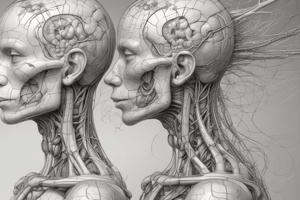Podcast
Questions and Answers
Which nerve is derived from the posterior ramus of C2 and supplies the skin of the occipital region?
Which nerve is derived from the posterior ramus of C2 and supplies the skin of the occipital region?
- Greater occipital nerve (correct)
- Third occipital nerve
- Lesser occipital nerve
- Great auricular nerve
What is the primary reason why deep lacerations to the scalp tend to bleed profusely?
What is the primary reason why deep lacerations to the scalp tend to bleed profusely?
- The pull of the occipitofrontalis muscle prevents the closure of the bleeding vessel and surrounding skin.
- The blood vessels to the scalp are adhered to dense connective tissue, preventing the vasoconstriction.
- The blood supply to the scalp is made up of many anastomoses.
- All of the above (correct)
Which of the following is a potential pathway for the spread of infection from the scalp to the intracranial space?
Which of the following is a potential pathway for the spread of infection from the scalp to the intracranial space?
- Emissary veins (correct)
- Sebaceous glands
- Cephalohematoma
- Occipitofrontalis muscle
What is the result of bleeding between the neonate's pericranium and calvaria during a difficult birth?
What is the result of bleeding between the neonate's pericranium and calvaria during a difficult birth?
Which nerve is derived from the anterior rami of C2 and C3 and supplies the skin posterior to the ear and over the angle of the mandible?
Which nerve is derived from the anterior rami of C2 and C3 and supplies the skin posterior to the ear and over the angle of the mandible?
What is the reason why the scalp is one of the most common sites for sebaceous cysts?
What is the reason why the scalp is one of the most common sites for sebaceous cysts?
What is the layer of the scalp that is considered the 'danger area'?
What is the layer of the scalp that is considered the 'danger area'?
Which nerve is derived from the posterior ramus of C3 and supplies the skin of the inferior occipital region?
Which nerve is derived from the posterior ramus of C3 and supplies the skin of the inferior occipital region?
Which of the following is NOT a reason why deep lacerations to the scalp tend to bleed profusely?
Which of the following is NOT a reason why deep lacerations to the scalp tend to bleed profusely?
What is the primary function of the emissary veins?
What is the primary function of the emissary veins?
Flashcards are hidden until you start studying
Study Notes
Blood Supply to the Scalp
- The scalp receives blood supply from the external carotid artery, which has three branches: superficial temporal, posterior auricular, and occipital.
- The superficial temporal artery supplies the frontal and temporal regions.
- The posterior auricular artery supplies the area superiorly and posteriorly to the auricle.
- The occipital artery supplies the back of the scalp.
- Additionally, the scalp receives supply from two branches of the ophthalmic artery: the supraorbital and supratrochlear arteries.
Venous Drainage
- The venous drainage of the scalp can be divided into superficial and deep components.
- The superficial drainage follows the arterial supply, including superficial temporal, occipital, posterior auricular, supraorbital, and supratrochlear veins.
- The deep (temporal) region of the skull is drained by the pterygoid venous plexus, which drains into the maxillary vein.
- The veins of the scalp connect to the diploic veins of the skull via valveless emissary veins.
Lymphatic Drainage
- The part of the scalp that is anterior to the auricles is drained to the parotid, submandibular, and deep cervical lymph nodes.
- The posterior part of the scalp is drained to the posterior auricular (mastoid) and occipital lymph nodes.
Nerve Supply to the Scalp
- The scalp receives cutaneous innervation from branches of the trigeminal nerve or the cervical nerve roots.
- The trigeminal nerve supplies the scalp through the following branches:
- Supratrochlear nerve: supplies the anteromedial forehead.
- Supraorbital nerve: supplies a large portion of the scalp between the anterolateral forehead and the vertex.
- Zygomaticotemporal nerve: supplies the temple.
- Auriculotemporal nerve: supplies the skin anterosuperior to the auricle.
Applied Anatomy
- Facial clefts can result in facial disfigurement, difficulties hearing, speaking, eating, swallowing, and breathing.
- Cleft lip occurs when there is a partial or complete lack of fusion of the maxillary prominence with the medial nasal prominence on one or both sides.
- Cleft palate can be divided into primary and secondary depending on whether they are in front of or behind the incisive foramen respectively.
Nerve Supply to the Scalp
- The cervical nerves also supply the scalp, including:
- Lesser occipital nerve: supplies the skin posterior to the ear.
- Greater occipital nerve: supplies the skin of the occipital region.
- Great auricular nerve: supplies the skin posterior to the ear and over the angle of the mandible.
- Third occipital nerve: supplies the skin of the inferior occipital region.
Applied Anatomy
- The connective tissue layer of the scalp is considered the "danger area" because it contains valveless emissary veins, which are a potential pathway for the spread of infection from the scalp to the intracranial space.
- Deep lacerations to the scalp tend to bleed profusely due to the pull of the occipitofrontalis muscle, the adherence of blood vessels to dense connective tissue, and the many anastomoses that contribute to profuse bleeding.
- Cephalohematoma is a collection of blood that occurs between the neonate's pericranium and calvaria, usually over one parietal bone, due to a rupture of multiple minute periosteal arteries.
- The scalp is one of the most common sites for sebaceous cysts due to the presence of numerous sebaceous glands.
Studying That Suits You
Use AI to generate personalized quizzes and flashcards to suit your learning preferences.




